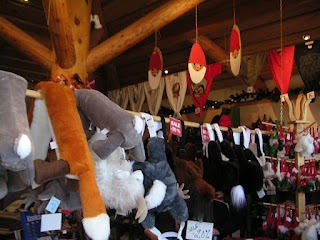
In 2004, my fourth year as a European Tour Manager, I was lucky enough to be selected on a one month Tour Manager training trip throughout Scandinavia, Russia and Central Europe.
One of the specialty talks I had to research and give was on Santa Claus/Father Christmas. This was because we were to be visiting his traditional home in a town called Rovaniemi on the Arctic Circle in Finland (exactly 66degrees 33' latitude!)

Contrary to popular thinking, Santa Claus (aka Father Christmas) could not possibly have a home at the North Pole as nothing, least not his reindeer could possibly live there - it's simply a barren, wind-swept, snow and frost-bitten hunk of ice!
More temperate and kind to his reindeer and elves, Rovaniemi in central Finland is still extremely remote (and is famous for being the home of the Eurovison uber-alternative metal-band "Lordy"!) yet not remote enough for him to have set up his home, workshop with elves, reindeer, park and official post office! (For the visitor to Santa's theme park, one can also have the "honour" of seeing Santa and have a photo with him (for the pricey sum of 20euros!!) as well as have your passport stamped there (technically a passport should NEVER be stamped with anything other than an official country border control stamp otherwise it could render it invalid!) and you can even send letters with stamps that will be stamped from Santa's very own post office!

For the visitor to his theme park, beware, if you are not into the over-commercialisation of Christmas and this legendary figure then I would recommend to stay in Rovaniemi and not visit his park.

Instead go and enjoy a reindeer stew or reindeer steak at one of the many "Saami" (ie local Lapplanders) restaurants in town instead! And no, reindeer doesn't taste like chicken!
Anyway, the man, the legend, how did it all begin...
HISTORY

- Developed from a real person – Saint Nicholas
- Lived in the AD's 300
- Was a Bishop of Mira – an ancient town of Lycia – now in Turkey
- Was only a boy when he became a bishop
- Was extremely kind & often went out at night - taking presents to the needy
- After his death his fame spread around Europe
- During the middle ages he became patron saint of schoolboys
- Schoolboys in various European towns began celebrating his birthday on Dec 6th by electing a boy-bishop
- Dressed in magnificent robes, the boy bishop would lead a parade through the streets
- Custom eventually died out but Saint Nicholas remained a favourite with children
- In Netherlands, people still celebrate his feast day – a person representing St Nick rides through the streets on a white horse
- In Germany, Austria, Hungary and Transilvania (now in Romania) he appears as a hairy imp to the children and the parents have to tell him whether the children have behaved or not (usually a relative or close family friend dresses up as St Nick) – good kids receive presents but bad ones receive only twigs
- Children were so fond of St Nick his habit of bringing gifts was maintained - Dutch settlers brought the tradition to New Amsterdam (New York) - English settlers borrowed the legend
- Dutch name for Saint Nick was "Sinterklaas" but English speakers found it hard to say so it became "Santa Claus". Imagine the young, excited children of Dutch settlers eagerly crying out "Sinterklaas, Sinterklaas, Sinterklaas" and you can see where "Santa Claus" comes from!
APPEARANCE

- For hundreds of years he was imagined as a tall, thin stately person
- Washington Irving (American writer) in 1809 created a new picture of him - like a typical Dutch settler – a jolly fellow, broad brimmed hat, huge breeches and smoking a pipe
- He rode over the treetops in a wagon and dropped presents from his pockets into the chimneys
- A famous American cartoonist Thomas Nast is credited with developing the appearance of Santa Claus as he is known today: late 1800's he drew some cartoons for Harpers' Weekly - jolly old man, white beard, in his workshop, or driving his sleigh pulled by reindeer or placing toys in stockings hung over the fireplace
- Dec 6 was celebrated as St Nick's day as is anniversary of his death
- After Protestant Reformation , Santa Claus was replaced by Christs Child or "Christkindl" in Germany and Switzerland – from this comes the character Kris Kringle – the angel-like figure who brings gifts at Christmas-time
- During Queen Victoria's time, Santa Claus became known as Father Christmas – a gentleman dressed in a long tail coat and square beaver hat – he appears at Christmas time. Over the years the two figures, Santa Claus and Father Christmas have more-or-less become one and the same in Western culture.
- Most European countries however celebrate Dec 6th as Saint Nicholas' day

Rumor has it that Coca Cola was responsible for giving Santa Claus his red and white colors from an advertisement from the early part of the 1900's. This however has become a part of urban legend and there were in fact other soda drink companies using his image in advertising even before Coke did.

























































